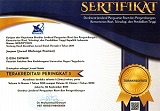Metode Latihan Basic Skill Sepak Bola untuk Siswa Sekolah Sepak Bola Usia 10-12 Tahun
DOI:
https://doi.org/10.21831/jorpres.v18i2.59848Keywords:
Latihan, Basic Skill, Sepak bola, Pemain usia mudaAbstract
Model Latihan sepak bola untuk usia muda harus sesuai dengan karakteristik perkembangan usia dan kebutuhan permainan dalam sepak bola. Tujuan dari artikel ini adalah (1) Mendeskripsikan pentingnya latihan Basicskill sepak bola untuk siswa Sekolah Sepak bola (SSB); (2) Mendeskripsikan Latihan basic skill sepak bola bagi pemain usia muda; (3) Mendeskripsikan metode latihan basic skill sepak bola untuk siswa SSB usia 10-12 tahun. Metode yang digunakan dalam penelitian ini adalah deskriptif kualitatif melalui literatur review yang relevan untuk dikaji secara konseptual dan disimpulkan dari hasil pembahasan. Hasil pengkajian ini menunjukkan (1) Latihan basic skill untuk siswa SSB usia 10-12 tahun sangat penting; (2) Latihan basicskill sepak bola bagi siswa SSB usia 10-12 tahun meliputi skill passing, receiving, dribbling, dan shooting; (3) metode percerption, decision making, dan execution dapat digunakan sebagai metode latihan basicskill sepak bola bagi siswa SSB usia 10-12 tahun. Metode dan model latihan yang tepat sangat diperlukan dalam program latihan sepak bola Indonesia. Metode latihan PDE mengarahkan pemain untuk tidak hanya fokus pada aspek eksekusi, tetapi juga aspek presepsi dan pengambilan keputusan.
References
Arianto, A., & Setyawan, C. (2019). Efektivitas small sided games dan interval training terhadap peningkatan daya tahan aerobik pada pemain sepak bola U-17. Jurnal Keolahragaan, 7(2), 182-191. https://doi.org/10.21831/jk.v7i2.27039
Bompa, T. O. (2009). Periodization: theory and methodology of training. 4th ed. In Champaign, Ill. : Human Kinetics;
Broich. H., Sperlich. B., Buitrago. S., Mathes. S., & Mester. J. (2012). Performance assessment in elite football players: field level test versus spiroergometry. Journal of Human Sport and Exercise, 7 (1), 287-295. https://doi:10.4100/jhse.2012.71.07
Carmona, A. C., Aliaga, A. G., Marquina, M., Calvo, J. L., Lopez, D. M., & Roman, I. R. (2020). What is the relevance in the passing action between the passer and the receiver in soccer? study of elite soccer in la liga. International Journal Environmental Research and Public Health, 17 (24), 1-15. https://doi.org/10.3390/ijerph17249396
Cross, K. (2013). The Football Coaching Process. 1–285.
Dahlan, F., Hidayat, R., & Syahruddin, S. (2020). Pengaruh komponen fisik dan motivasi latihan terhadap keterampilan bermain sepak bola. Jurnal Keolahragaan, 8 (2), 126- 139. https://doi.org/10.21831/jk.v8i2.32833
Darmawan, R., & Putera, G. (2012). Jadi juara dengan sepak bola possession. Jakarta: KickOff Media-RD Books.
Dheng, W., & Zhong, E. (2020). Analysis and prediction of soccer games: an application to the kaggle european soccer database. Jurnal of Insight Series, 3 (1), 1-6. http://dx.doi.org/10.18282/i-s.v3i1.332
Diminin, A., Frattini, F., Bianchi, M., Bortoluzzi, G., & Piccaluga, A. (2014). Udinese Calcio soccer club as a talents factory: Strategic agility, diverging objectives, and resource constraints. European Management Journal, 32(2), 319–336. https://doi.org/10.1016/j.emj.2013.04.001
Handoko, A. H. (2018). Analisis kemampuan teknik dasar pemain sepak bola ssb deli serdang united kabupaten deli serdang. Jurnal Olahraga Prestasi, 14 (1), 64-80. https://doi.org/10.21831/jorpres.v14i1.19982
Irianto, S. (2016). Kebugaran aerobik pemain sepak bola psim yogyakarta tahun 2014. Jurnal Olahraga Prestasi, 12 (2), 1 8. https://doi.org/10.21831/jorpres.v12i2.11871
Islam, M. S., & Kundu. (2020). Soccer passing accuracy differentiates between high and low digit ratio (2d:4d) soccer players. American Journal of Sport Science, 8 (3), 49-55. https://doi: 10.11648/j.ajss.20200803.11
Karki, B., Ambadapoodi, R., Imran, Z., & Ramirez, J. A. (2020). Covid-19 spread in europe: the soccer connection. The University of Louisville Journal of Respiratory Infections, 4 (1), 1-5. https://doi.org/10.18297/jri/vol4/iss1/46
Komarudin (2021). Konsep long term athlete development dalam sepak bola. Yogyakarta: UNY pres.
Mikail, K., & Suharjana (2019). Pengembangan model latihan teknik dasar sepak bola bagi anak usia 10-12 tahun di sekolah sepak bola. Jurnal Olahraga Prestasi, 15 (1), 14-27. https://doi.org/10.21831/jorpres.v15i1.26023
Naufal, R (2020). Pembeda Pemain Sepak Bola. panditfootball.com
Pappalardo, L., & Cintia, P. (2017). Quantifying the relation between performance and success in soccer. Journal of World Scientific, 21 (3), 1-29. https://doi.org/10.1142/S021952591750014X
Parganas, P., & Anagnostopoulos, C. (2015). Social media strategy in professional football: the case of liverpool fc. Sport Management International Journal, 11 (2), 62-75. http:dx.doi.org/10.4127/ch.2015.0102
Prawira, R. Z. R., & Tribinuka, T. (2016). Pembinaan Pemain Muda Melalui Akademi Sepak Bola Rengga. Jurnal Sains Dan Seni Its, 5(2), 13–17.
PSSI. (2017). Filosofi sepak bola Indonesia. Jakarta: PSSI.
PSSI. (2021). Konsep pembinaan sepak bola Indonesia. Makalah disajikan dalam Kursus Lisensi C PSSI Diploma AFC, di Yogyakarta.
Pujianto., Sutisyana., & Arwin (2020). Pengembangan model latihan sasaran berbasis permainan untuk meningkatkan kemampuan passing sepak bola. Jurnal Pendidikan Jasmanidan Olahraga. 19 (1), 67-73. http://dx.doi.org/10.20527/multilateral.v19i1.8333
Saputro, Y. D (2017). Pengembangan model latihan shooting dalam permainan sepak bola di sekolah sepak bola indonesia muda (IM) malang. Jurnal Jendela Olahraga, 2 (1), 129-139. https://doi.org/10.26877/jo.v2i1.1291
Sugiyono. (2012). Metode penelitian pendidikan pendekatan kuantitatif, kualitatif dan R&D. Bandung: Alfabeta.
Sukadiyanto. (2011). Pengantar teori dan metodologi melatih fisik. Yogyakarta: UNY.
Susanto, N., & Lismadiana, L. (2016). Manajemen program latihan sekolah sepak bola (SSB) Gama Yogyakarta. Jurnal Keolahragaan, 4(1), 98-110. https://doi.org/10.21831/jk.v4i1.8133
Tamboer, Jan. 2015. Football Theory. Amsterdam. World Football Academy.
Verheijen, Raymond. 2014. Football Periodization. Amsterdam. World Football Academy
Downloads
Published
How to Cite
Issue
Section
License
Authors who publish with this journal agree to the following terms:
- Authors retain copyright and grant the journal right of first publication with the work simultaneously licensed under a Creative Commons Attribution License that allows others to share the work with an acknowledgement of the work's authorship and initial publication in this journal.
- Authors are able to enter into separate, additional contractual arrangements for the non-exclusive distribution of the journal's published version of the work (e.g., post it to an institutional repository or publish it in a book), with an acknowledgement of its initial publication in this journal.
- Authors are permitted and encouraged to post their work online (e.g., in institutional repositories or on their website) prior to and during the submission process, as it can lead to productive exchanges, as well as earlier and greater citation of published work (See The Effect of Open Access).




